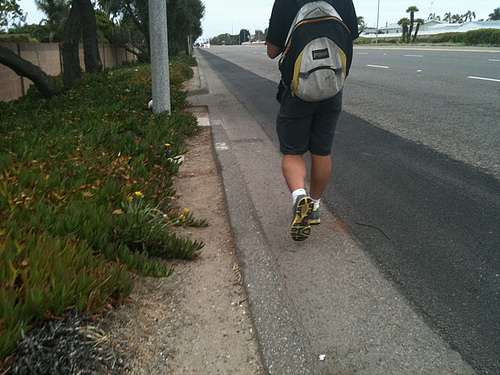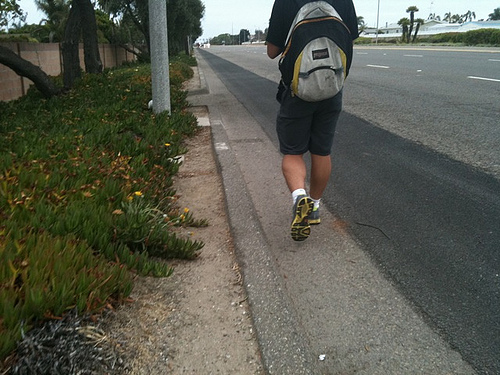 No safe passage.Photo: Caro ScuroPedestrian advocates sometimes talk about an attitude called “windshield perspective.” That’s the point of view people develop when their ass is planted firmly in the driver’s seat — a point of view in which people on the other side of the glass are somehow always responsible for everything that happens to them.
No safe passage.Photo: Caro ScuroPedestrian advocates sometimes talk about an attitude called “windshield perspective.” That’s the point of view people develop when their ass is planted firmly in the driver’s seat — a point of view in which people on the other side of the glass are somehow always responsible for everything that happens to them.
Once you’re aware of the concept, windshield perspective turns out to be everywhere. Cops have it. Courts have it. Reporters have it. You can develop it yourself surprisingly quickly.
So it’s hardly surprising that The Wall Street Journal‘s Pulitzer-winning “automotive critic,” Dan Neil, suffers from a bad case of windshield perspective. But even so, after reading his review of the 2012 Volvo S60 T5 AWD, we’ve gotta say: Wow.
The newsworthy feature of this Volvo is that in addition to being safer for the people inside the vehicle, as the Swedish cars notoriously are, it also offers an optional “pedestrian detection and full auto brake” system that automatically brakes the car to avoid hitting objects — people, for instance — that might be in the car’s path. (See it in action here.) It’s the type of “Intelligent Vehicle System” that is going to be showing up more and more, which could be a good thing. After all, more than 4,000 American people were killed by cars when they were on foot last year.
Neil takes the review as an opportunity to go off onto an extended, tongue-in-cheek rant against pedestrians in general, claiming that driving in Los Angeles, “where pedestrians are possessed of the belief they are from the planet Krypton,” is far more terrifying than even navigating Bolivia’s notorious “Highway of Death”:
[W]hile one cannot know the state of mind of complete strangers, it seems that a few of these pedestrians are daring me to hit them — slowing their stride, loitering provocatively in the lane — in a way that’s partly aggressive and fully suicidal.
Neil goes on to interpret statistics on pedestrian fatalities in an intriguing way:
The presumption is that pedestrians are defenseless against automobiles and must be protected. Even so, the feds’ safety statistics suggest that pedestrians are more often to blame in these incidents. In 2009, nearly 40% of pedestrian fatalities were caused by pedestrians’ improper crossing or walking/playing/working in the roadway, according to the National Highway Traffic Safety Administration.
Let’s just rewind for a second: first of all, 40 percent of the time is not “more often,” last time I checked.
Second, I went and looked at those NHTSA numbers (available as a PDF here). The actual percentage in the categories Neil cites add up to 37.8 percent, and all pedestrian statistics come with the caveat that “The sum of the numbers and percentages is greater than total pedestrians killed as more than one factor may be present for the same pedestrian.”
Neil then goes on to say this:
Urban planners may argue that these statistics suggest not negligent pedestrians but poorly designed urban environments, inherently hostile to walkers. I’m sure that’s true, but we take the world, and cross the street, as we find it.
That’s exactly the point: We cross the street as we find it. And the way we find it is all too often life-threatening for anyone who is not protected by a metal shell with an internal combustion engine.
When I last went to visit my mother in Pahrump, Nev., a town of 40,000, I was forced to drive to get to a restaurant that was about 200 yards from my hotel, directly across the street. Especially with a 7-year-old kid in tow, there was no way I was going to risk the crossing on foot, even in broad daylight. Using the nearest crosswalk (one of Pahrump’s very few) would have meant a two-mile trek along the busy highway that cuts through town.
Those are the kinds of conditions that exist almost everywhere in America. It doesn’t have to be like this — some 200 communities around the country have enacting what is known as “complete streets” policies, requiring new and rebuilt roads to provide accommodation for pedestrians and other vulnerable road users. Because at some point or other, we all are in the category of pedestrian.
And yet when people talk about pedestrian behavior, so often the tone is the one that the WSJ‘s Neil takes — one of sarcastic aggravation at those crazy people who actually want to walk somewhere — or, more contemptibly still, actually have to walk somewhere because they are too poor to travel in the style to which he is accustomed. The “walking have-nots,” Neil calls them.
This deeply felt hostility toward pedestrians made a ripple in the news last week after the release last week of a report from the Governors Highway Safety Association (GHSA).
The GHSA’s Executive Director Barbara Harsha told us she was misquoted in a Washington Examiner piece that implied First Lady Michell Obama’s “Let’s Move” campaign was perhaps in part to blame for an increase in pedestrian fatalities.
But the GHSA’s press release contained this quote from Troy E. Costales, GHSA’s vice chairman and head of Oregon’s highway safety program:
Looking at our data, we are seeing pedestrians crossing mid-block instead of at crosswalks, pedestrians walking in the roadway, and even some walking in the travel lanes of the interstate. We are familiar with aggressive drivers; we now have aggressive pedestrians.
Aggressive pedestrians. Sounds a lot like the “asphalt toreadors” that the WSJ‘s Neil pokes fun at in his Volvo review.
As Transportation for America pointed out in a blog item about the GHSA controversy:
Pedestrians are dying by the thousands, and it’s not because they’re using an iPod while crossing the street or trying to get more exercise at the First Lady’s urging. It’s because our basic choices about road design have left far too many without a safe place to walk, putting too many pedestrians in harm’s way.
For now, smart-car systems like the Volvo’s pedestrian-detection feature are optional, limited, and pricey. The WSJ‘s Neil poses this question:
[W]ould you pay extra — Pedestrian Detection is part of Volvo’s optional $2,100 technology package — to protect those outside your vehicle, to save the health and perhaps life of a stranger?
I would ask something more radical of drivers: Would you look through your windshield an
d see the people using their feet to travel not as annoyances, not as objects of pity or contempt, not as figures in a video game, but as human beings? Could you take the extra moment, the extra breath, to let a person pass before you accelerate through a crosswalk? Could you drive the speed limit, at least in residential neighborhoods?
Could you recognize that sometimes, inevitably, the person on the other side of the windshield is you?




